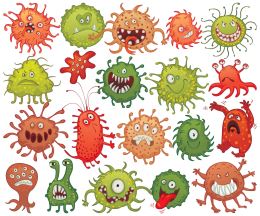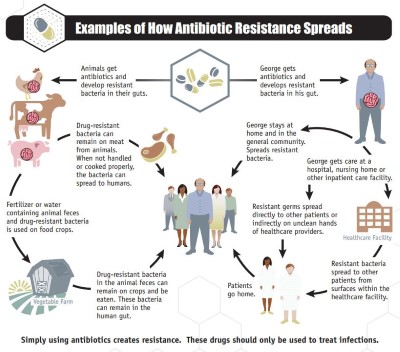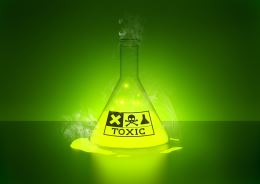DrCarney.com Blog
What's in Your Holiday Turkey Besides Stuffing?
Traditional holiday celebrations typically feature a turkey or other poultry product as the centerpiece of the meal. In fact, 46 million turkeys are eaten every Thanksgiving and 22 million for Christmas in the United States. Yet consuming poultry products doesn't come without risks. We've highlighted many of Dr. Michael Greger's videos regarding the health hazards associated with bacterial contamination and toxic additives found in these products. Many consumers are concerned about GMOs not being listed on labels...yet there's more that's not on labels. You may be surprised to see what's inside your holiday turkey besides just the stuffing!
Every year, hundreds of thousands of pounds of meat are recalled due to fecal bacterial contamination. Poultry and turkey products in particular contain high levels of fecal bacteria. The bacteria originate in the birds' intestines but is easily spread due to filthy living conditions, transportation, slaughtering, and processing. Although the birds are checked for visible fecal matter, fecal traces are not typically visible. Large processing plants can slaughter more than a million birds per week - 30,000 chickens per hour, or 140 birds per minute, which provides minimal time for inspectors to visually inspect every bird.
According to the PCRM article, The Five Worst Contaminates in Chicken Products, a federal inspector said, "We often see birds going down the line with intestines still attached, which are full of fecal contamination. "...However, we can do nothing to stop that bird from going down that line. It is more than reasonable to assume that once the bird gets into the chill tank, that contamination will enter the water and contaminate all of the other carcasses in the chiller. That's why it is sometimes called fecal soup." As the birds are soaking, they absorb the contaminated water into their muscle - which adds weight. Since chicken is sold by the pound, this results in higher profits for the industry (8-12% retained water.) These chill tanks contain chlorine and other antimicrobial chemicals. Dr. Neal Barnard does an excellent job explaining how this fecal soup ends up on dinner plates in this 2-minute video.
What Percentage of Turkey and Chicken Products Test Positive for Fecal Contamination?
Recently, laser imaging has been used to detect fecal residue on poultry carcasses, revealing nine out of ten (or 92%) of retail chicken carcasses contaminated with fecal matter. When Consumer Reports tested over 300 chicken samples from 26 states, over 97% of products tested positive for some bacterium. "Enterococcus, a typical measure of fecal contamination, was found in 79.8% of samples, according to the report. The second most common bacteria was E. coli (65.2%), followed by Campylobacter (43%), klebsiella pneumoniae (13.6%), Salmonella (10.8%) and staphylococcus aureus (9.2%). Sampling also revealed that roughly half of the birds were contaminated with at least one bacterium that was resistant to at least three commonly prescribed antibiotics. Antibiotic-resistant infections are linked to at least 2 million illnesses and 23,000 deaths in the U.S. each year. If antibiotic-resistant bacteria continue to spread, they could lead to deadly infection after routine surgery or even a seemingly innocuous cut because the drugs that doctors prescribe will have lose their effectiveness."
Based on over 5,000 samples, a 2010 FDA Retail Meat Report stated 90% of turkey and 95% of chicken breasts were contaminated with fecal bacteria. "Enterococcus isolates (both susceptible and resistant) were found on 95.4% of chicken breasts and 90.7% of ground turkey. Nearly 78% of chicken breasts had E. coli, as did 80% of ground turkey."
The Centers for Disease Control reports only 7 out of 10 samples of beef testing positive for E. coli, whereas 9 out of 10 packages of both ground turkey and chicken breasts are contaminated.
In a Meat Eater's House, Toilet Seats Have Less Bacteria Than Their Kitchen Counter Tops
Feces from poultry products are easily transferred throughout the entire kitchen as well onto other family members. Click here to watch how bacteria can spread when the product is washed under running water. Besides E.coli, two other types of bacteria, Salmonella and Campylobacter are also found in poultry including organically raised poultry. A study revealed Salmonella and Campylobacter "all over the kitchen—on the cutting board, the utensils, on their hands, on the fridge handle, on the cupboard, the oven handle, door knob and everything". Interestingly, researchers in Arizona found more fecal bacteria in the kitchens (of those that eat meat) than in their bathroom toilets. After swabbing both the kitchen and bathroom, more bacteria was found on kitchen sponges, dish towels and the sink drain than the toilet. "Even after bleaching everything twice, in a meat eater's house it is safer to lick the rim of the toilet seat than the kitchen counter top..." Dr. Michael Greger adds that there is "no such thing as the 24-hour or 48-hour stomach-flu." When people are home sick with the stomach bug what they likely have is food poisoning. "Frankly, you know that chicken juice isn't juice, it's raw fecal soup."
Salmonella
"Salmonella is ranked the food poisoning bacteria with the greatest public health burden on our country, the leading cause of food poisoning hospitalization, and the #1 cause of food-related death. According to the FDA, 142,000 Americans are sickened every year by eggs contaminated with Salmonella. But salmonella in eggs was only ranked the #10 worst pathogen-food combination. Salmonella in poultry ranks even worse, the #4 worst infected food in the United States. Eating chicken may be 8 times riskier than eating eggs. There's fecal matter in about two-thirds of American beef, but more than 80% in poultry—chicken and turkey." Salmonella can trigger Reiter's Syndrome, "where you come down with Salmonella food poisoning once, and you can end up with chronic, debilitating arthritis for the rest of your life. One in seven retail packages of poultry has the potential to permanently cripple us."
Campylobacter
"More than half of the retail poultry in the world is contaminated with the food poisoning bacteria Campylobacter."
 Image from Fotolia.com
Image from Fotolia.com
Approximately 70% of poultry in the United States is contaminated with this fecal pathogen. In some cases, some strains of campylobacter can create severe complications and even cause nerve damage and paralysis in an autoimmune condition called Guillain-Barre syndrome. Dr. Greger says it's a "brutally rapid, life-threatening attack on your nervous system. It's like MS in fast-forward, where instead of taking years, you can end up paralyzed on a ventilator in a matter of days from not being able to breathe on your own." The severity of campylobacter poisoning varies. "The most common cause of neuromuscular paralysis in the United States now comes from eating chicken."
"Researchers at Hopkins and UCLA recently looked into the prevalence of the potentially neuropathic strains of campylobacter in commercial poultry products, right off of supermarket shelves. Of 65 isolates of campylobacter they found, only about 60% were in the three classes most associated with the development of paralysis. The odds may be 50;50 or so that you might be bringing home something that could trigger Guillain-Barre syndrome."
MRSA - Methicillin Resistant Staph Areaus
A super bug called MRSA (Methicillin Resistant Staph Areaus) used to be seen mainly in patients that were hospitalized until it became prevalent among people out in the community. This bacteria is now killing more Americans than AIDS every year in the United States. When farm workers were tested, approximately half of them tested positive. This led to the discovery that a certain strain of MRSA can jump from livestock (pigs, veal calves, poultry and dairy cows) to humans. "Airborne MRSA was found floating around even outside confinement buildings. The exhaust fans can blow MRSA superbugs straight out into the surrounding area from pig or poultry operations. You can find MRSA floating around outside these sheds containing thousands of turkeys or chickens." Approximately 5% of meat containing MRSA is now found in our retail meat supply. MRSA can easily transfer to our skin, cutting boards, knives and other surfaces "at a rate similar to the rate of transmission from touching an infected patient contaminated with MRSA."
Listeria
"The third leading cause of foodborne disease-related death in the United States is listeria, a type of foodborne bacteria that has the rare ability to survive and thrive in cold, acidic, salty environments, otherwise known as deli meats, hot dogs, and refrigerated ready-to-eat chicken and turkey products. The fatality rate of infection is 20-30%, making it the most dangerous foodborne bacteria in our country's meat supply."
Staphylococcus
"In May 2011 researchers published an investigation into the prevalence of the multi-drug resistant staph bacteria in the United States meat supply. Surveys conducted indicate that retail meat and poultry products are frequently contaminated with multidrug-resistant Campylobacter, Salmonella, Enterococcus, and E coli. Staph contamination was most common among turkey samples, followed by pork, chicken, then beef. Three-quarters of retail turkey tested positive. Overall, 47% of U.S. retail meat tested was found contaminated with staph, and multidrug resistance was common." Staph bacteria not only cause food poisoning and skin infections, but also pneumonia, meningitis, and urinary, bloodstream and other infections.
Clostridium difficile - C. diff.
Clostridium difficile, also known as C. diff is the "new superbug in town." Like MRSA, it too was once seen only in hospitals, until it was discovered in poultry and other meat products sold in grocery stores. In fact, "42% of meat products sampled contained toxin-producing C diff. The riskiest meat was ground turkey. Relatively common in retail chicken too, the riskiest body part are chicken wings." Once a person is infected with C diff, it normally just "waits patiently until you have to take an antibiotic. With your good bacteria out of the way, C diff can go crazy, and cause a severe infection of your colon, called pseudomembraneous colitis which can get worse, and turn into a life-threatening condition called toxic megacolon." Seventy-one degrees Celsius is the recommended internal temperature to kill bacteria on most meat. However, meat containing C. diff can "survive 2 hours at that temperature. Chicken can be grilled for 2 hours straight and still not kill off C diff." Even the alcohol-based hand sanitizers cannot kill it.
It's Legal in the United States to sell Salmonella Infected Poultry Products
"While consumers are counseled by the USDA to apply high cooking heat to poultry products, this treatment simply cooks the feces along with the muscle tissue and does nothing to remove it from the ingested product." Although it's illegal to sell Salmonella-contaminated chicken in Sweden it's perfectly legal for industries in the United States to sell Salmonella-infected meat. The industry knows the dangers associated with selling contaminated meat products, however, they place the responsibility and blame on the consumer for improper handling or cooking methods. Sadly, many children have died as a result from contaminated meat products. More information can be found here.
Organic Poultry Just as Likely to Contain Bacteria
According to the Consumer Reports study, "Ground turkey labeled 'no antibiotics,' 'organic,' or 'raised without antibiotics' was as likely to harbor bacteria as products without those claims. After all, even meat from organic birds can pick up bacteria during slaughter or processing." A 2010 study by Consumer Reports showed no salmonella on organic poultry samples, although 57 percent of those birds harbored campylobacter.
Antibiotic Resistance
Antibiotics have been used in poultry farming in large quantities since the 1940s. "Antibiotics are used 
Unfortunately, 80 percent of antibiotics purchased in the United States are fed to livestock which contributes to the rise of antibiotic-resistant bacteria in food-producing animals. This "helps breed resilient superbugs that are able to spread in the environment, contaminate food supplies and undermine the effectiveness of antibiotics. The superbug infections can appear practically anywhere, but they're especially deadly when they're spread in hospitals, nursing homes or other health care centers."
"When animals receive unnecessary antibiotics, bacteria can become resistant to the drugs, then travel on meat to the store, and end up causing hard-to-treat illnesses in people." According to the CDC, at a minimum every year, "more than two million people are sickened with antibiotic-resistant infections in the United States, with at least 23,000 dying as a result."
As reported by the CDC, "multidrug-resistant E. coli and Enterococcus species are prevalent among US meat and poultry products." An article by Consumer Reports states: "That practice is speeding the growth of drug-resistant superbugs, a serious health concern. People sickened by those bacteria might need to try several antibiotics before one succeeds. Almost all of the disease-causing organisms in our 257 samples proved resistant to one or more of the antibiotics commonly used to fight them. Eight ground turkey samples harbored salmonella that resisted three or more antibiotic classes. Sixty-nine percent of ground turkey samples harbored enterococcus, and 60 percent harbored Escherichia coli. About 80% of the enterococcus bacteria were resistant to three or more groups of closely related antibiotics as were more than half of the E. coli. Three samples were contaminated with MRSA which can cause fatal infections. Some samples harbored staphylococcus aureus." The highest contamination rates for Enterococcus faecalis and multidrug-resistant Enteroccocusfaecium was found in turkey. Most poultry in the U.S. containing Campylobacter has been reported to be antibiotic resistant." Click here for more information on antibiotic resistance.
Listing the Risks of Bacteria on Poultry Products = Decline in Sales $$
Consumer surveys show that consumers would prefer to see information regarding meat and eggs as likely contamination sources with food-borne pathogens like Salmonella and Campylobacter, yet this may result in a drop of poultry meat and egg consumption.
Salt Injected into Poultry
Every year, more meat companies are adding salt water, seaweed, chicken stock and/or other ingredients in order to make their product moist and tasty. This is referred to as plumping or enhancing. According to the USDA, "30 percent of poultry, 15 percent of beef, and 90 percent of pork contain added solutions." Whole poultry may be injected with salt water using needles or it may be soaked in brine. Many poultry processors label their salt-enhanced products as "all natural."
"100% Natural and even Organic does not mean that the chicken has not been injected with salt water. Check the ingredient list and the sodium content - chicken meat contains approximately 75 mg sodium per 4-ounce serving – plumped chicken may list up to 440 mg sodium for the same serving size." Additional sources list 550 mg of sodium per 4 oz. serving while Consumer Reports found some products registered at 840 mg per serving. Click here to watch a video clip on how this procedure is done.
Carbon Monoxide Added to Maintain Meat's Red Appearance
In 2004, carbon monoxide was approved by the FDA to maintain the fresh red appearance of meat in a process called modified atmosphere packaging (MAP). "It's speculated that more than 70 percent of all beef and chicken in the United States and Canada are being treated with carbon monoxide gas." When carbon monoxide is added to meat, it "increases the meat packers' profit by reducing the number of times meat is repackaged. Adding a small amount of CO to pre-packaged red meat makes the meat appear bright red for up to several weeks longer than untreated meat."
Many other countries have banned the use of carbon monoxide in meat.The use of carbon monoxide on meat to preserve its red color can be potentially dangerous. Meat can appear to be fresh, (even for several years) when it may not be; thus greatly increasing the risk of bacterial contamination. Click here to view the CBS News report and here for CNN.
Arsenic Added to Poultry Feed
 Image from Fotolia.comA few years ago, arsenic in rice was big news. Arsenic, a known human carcinogen, is harmful, but the majority (75%) of arsenic in the American diet comes from animal products - beef, milk, pork, hot dogs, eggs, and poultry. Perdue was found to be the most contaminated. "One bucket of American fast food chicken may exceed the EPA safety limit for arsenic in a glass of drinking water by 2000%." Although not approved in other countries, the FDA approved arsenic as an additive to poultry feed to increase the rate of weight gain and control parasites. "Two million pounds of arsenic compounds were fed to chickens every year in the United States, and about 85 tons fed to pigs. When you cram tens of thousands of birds into filthy football field-sized sheds to lie beak to beak in their own waste they become so heavily infested with internal parasites that adding arsenic to the feed to poison the bugs can result in a dramatic increase in growth rates. It's also approved for use to 'improve pigmentation.' Arsenic can give the carcass a pinkish tinge, which consumers prefer." As the industry profits go up, so does the incidence of cancer, heart disease, diabetes, neuropathy and neurocognitive deficits in children.
Image from Fotolia.comA few years ago, arsenic in rice was big news. Arsenic, a known human carcinogen, is harmful, but the majority (75%) of arsenic in the American diet comes from animal products - beef, milk, pork, hot dogs, eggs, and poultry. Perdue was found to be the most contaminated. "One bucket of American fast food chicken may exceed the EPA safety limit for arsenic in a glass of drinking water by 2000%." Although not approved in other countries, the FDA approved arsenic as an additive to poultry feed to increase the rate of weight gain and control parasites. "Two million pounds of arsenic compounds were fed to chickens every year in the United States, and about 85 tons fed to pigs. When you cram tens of thousands of birds into filthy football field-sized sheds to lie beak to beak in their own waste they become so heavily infested with internal parasites that adding arsenic to the feed to poison the bugs can result in a dramatic increase in growth rates. It's also approved for use to 'improve pigmentation.' Arsenic can give the carcass a pinkish tinge, which consumers prefer." As the industry profits go up, so does the incidence of cancer, heart disease, diabetes, neuropathy and neurocognitive deficits in children.
Poultry manure containing arsenic is then released into the environment, contaminating the air and soil where rice may be grown. Arsenic is even seen in organic brown rice syrup. For over 70 years, "arsenic-containing poultry drugs have been deliberately administered to animals intended for human consumption." Several lawsuits from consumer groups have petitioned for the removal of arsenic-containing drugs fed to poultry. More information here.
Flame Retardant Chemicals
Flame-retardant chemicals are added to manufactured materials and have been associated with serious health risks. Consumers are exposed to flame-retardant chemicals through several ways. The primary source of exposure is through our diet (20-40%). These chemicals concentrate in the fat of meat products such as chicken, turkey, red meat, fish, eggs and other fatty meats while the concentration in whole plant foods is very low.
Meat Glue
To add value, the meat industry uses a meat glue enzyme called transglutaminase. Smaller scraps of meat are glued together to form a larger chunk. "The American Meat Institute estimates it's used in about 8 million pounds of meat every year in the United States. When these researchers actually tested for it in 20 samples of meat from the supermarket, they only found meat glue in salmon and turkey." Discarded questionable leftovers can be glued together, which raises safety concerns regarding microbial quality. A microscope can detect E. coli that was introduced along the glue lines, which "translocates fecal matter from the surface and contaminates the interior of the meat. Furthermore, people who have problems with gluten may develop problems when ingesting meat treated with the meat glue enzyme, since it functions as an autoantigen capable of inducing an autoimmune reaction." Another video can be seen here.
Phosphate Additives in Chicken
The U.S. allows 11 different phosphate salts to be injected into meat and poultry, although this procedure is banned in other countries. Phosphate is used as a preservative and to enhance the color of meat. Phosphate is "considered an arterial toxin, causing our arteries to stiffen up within just two hours of consumption, making modern poultry not only more dangerous from a heart disease standpoint, but may also be making poultry more dangerous from a food safety standpoint. The addition of phosphates to chicken has the potential to increase the survival of Campylobacter by 100 fold or more. The infectious dose for campylobacter has been shown to be as little as 500 organisms. Whole chicken carcasses can easily contain 100,000. A million times more food poisoning fecal bacteria can mean a 30 fold difference in the number of human outbreaks of Campylobacter, a food-borne disease that can leave people paralyzed. Having high levels in our blood has been found to be an independent predictor of heart attacks and mortality in the general population, increasing the risk of not only kidney failure, but heart failure, heart attacks, coronary death and overall death. Higher phosphate levels associated with a significantly shorter lifespan. Dietary intake of phosphate is an important matter for everybody. It's thought to cause damage to blood vessels and accelerate the aging process, and even potentially hurt our bones, by contributing to osteoporosis by disrupting hormonal regulation."
How to Avoid Phosphate Additives
More than 90% of poultry products have been found to contain injected phosphates, however, most don't list the additive on the label. Many times phosphate additives are listed as broth or flavorings. Anything with the four letters: p.h.o.s. as an ingredient should be minimized. "Phosphorus-containing additives are present in most meat products and significantly increase the phosphorus content. Moreover, the lack of this information in the Nutrition Facts labels and even in nutrition databases prevents patients and dietitians from accurately estimating food phosphorus content and intake."
Illegal Drugs Found in Chicken Feathers
One-third of a bird is not edible, thus, billions of pounds of heads, bones, guts, manure and feathers are ground up and turned into feather meal, which is fed to poultry, livestock and fish. Arsenic (which is not only found in the meat, but also in the feathers) "contributes to additional arsenic exposure in persons who consume meat."
When feather meal was tested, "between 2 to 10 different kinds of antibiotics were found in each sample, including fluoroquinolones, which have been banned for years. So either the poultry industry is illegally still using the stuff or it's being used in some other animals fed to the chicken. Regardless, when the feather meal is fed back to the chickens they are getting exposed to this drug, which is against the law to feed to chickens, creating a cycle of re-exposure to banned drugs." Other drugs that were found include Prozac, antihistamine, fungicide, a sex hormone and caffeine. "Evidently the antihistamines are to combat the respiratory problems from packing so many tens of thousands into the confinement sheds, and the caffeine helps keeps the chickens stay awake so that they eat more and grow."
Industrial Toxins Accumulate Higher up the Food Chain
In the U.S. part of industrialized farming practices includes cannibalistic acts such as feeding farm animals to other farm animals. This meal includes slaughterhouse waste, blood, and manure. Not only are mad cow prions found in meat, but also pesticides, pollutants, and neurotoxic substances such as methylmercury and lead. These toxins accumulate in fat tissues and bones. As a result, "when farm animals are fed meat and bone meal, the toxins biomagnify - bioaccumulate up the food chain." Therefore, eating low on the food chain greatly reduces our risk for consuming contaminated animal products.
Industrial Pollutants
Perfluorochemicals (including PCBs, DDT, Hexachlorobenzene and organochlorine pesticides) are industrial pollutants, some of which have been linked to thyroid disease. The highest levels are found in the United States, coming from meat, fish, fats, cheese, eggs, dairy and poultry. A long list of toxic chemicals in which we are exposed to can be seen here. Our planet has become so polluted, these chemicals come down in rain and "concentrate their way up the food chain. The best we can do is eat as low on the food chain as possible, plant foods, preferably organic."
Dioxins Found in Meat
"Every five years, our government measures the amount of dioxins in our food supply. Dioxins are toxic waste pollutants spewed out into the atmosphere that accumulate in the fatty tissues of humans, and food animals consumed by humans. The most significant exposure to dioxin-like compounds is thought to be dietary intake of meat, fish and dairy products." Although levels continue to decline, data from the EPA indicates that we are still being exposed to DDT even though it was banned decades ago. "Increasing evidence suggests that maternal exposure to toxic chemical compounds may be associated with various birth defects, pediatric problems, skewed gender ratios, lethal cancers in children and teens, psychosexual challenges, as well as reproductive and hormonal dysfunction in later life."
Resources by Dr. Michael Greger used for this article:
(1) Chicken "Fecal Soup" Contamination
(3) Talking Turkey: 9 out of 10 retail turkey samples contaminated with fecal bacteria
(4) Why is it Legal to Sell Unsafe Meat?
(5) Salmonella in Chicken & Turkey: Deadly But Not Illegal
(6) Fecal Contamination in Retail Chicken Products
(7) Chicken Salmonella Thanks to Meat Industry Lawsuit
(8) Food Poisoning Bacteria Cross-Contamination
(11) Antibiotics: Agribusinesses' Pound of Flesh
(13) U.S. Meat Supply Flying at Half Staph
(14) How Many Cancers Have Been Caused by Arsenic-Laced Chicken?
(15) The Five Worst Contaminants in Chicken Products
(16) Fecal Residues on Chicken
(17) Is Meat Glue Safe?
(19) Bird Flu: A Virus of Our Own Hatching
(20) Food Sources of Flame Retardant Chemicals
(22) Salt OK if Blood Pressure is OK?
(23) Chicken Salmonella Thanks to Meat Industry Lawsuit
(24) Dioxins in the Food Supply
(25) Phosphate Additives in Chicken
(26) How to Avoid Phosphate Additives
(27) Phosphate Additives in Meat Purge and Cola
(28) Food Sources of Perfluorochemicals
(29) Illegal Drugs in Chicken Feathers
(30) Food Sources of Perfluorochemicals
(31) Bird Flu: A Virus of Our Own Hatching
(32) The Five Worst Contaminants in Chicken Products
(33) Fecal Contamination in Retail Chicken Products
(34) Cannibalistic Feed Biomagnification
(35) 100% of Ground Beef Samples Contain Fecal Bacteria
Michael Greger MD Links
Preview the "Why We Do What We Do?" Trailer
Controlling Cravings: Have you ever asked yourself "Why did I eat that?" Get science-based answers, now! Gain freedom from addictions. Understand underlying causes. Make lasting changes more easily than ever. Strengthen your ability to choose healthy foods through empowerment from Dr. Carney's Starch-Smart® System. Let's boost your 'biochemical willpower' for good. Help is here, from Linda Carney, MD, for all who struggle with bad habits, food fixations, and cravings.
When you subscribe to the blog, we will send you an e-mail when there are new updates on the site so you wouldn't miss them.




